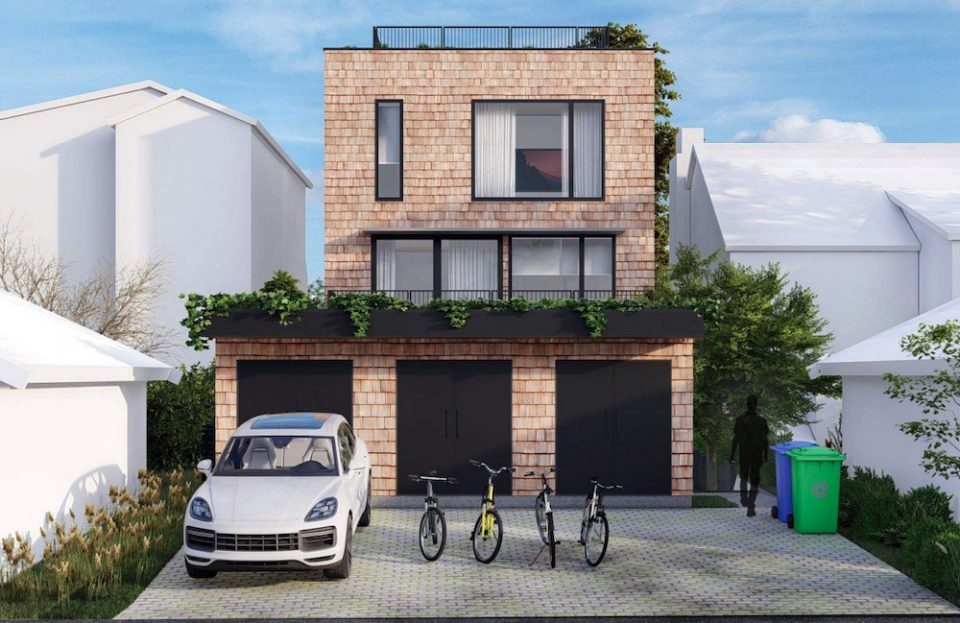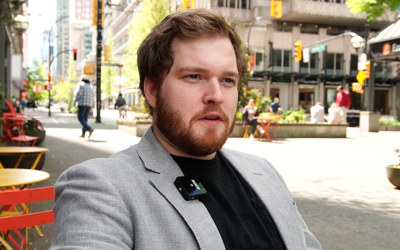Ask the Experts: How Gentle Density Adds Housing Solutions
In this episode of ‘Ask The Experts’, we talk with Tamara White, the Associate Executive Director of Small Housing BC (SHBC) to learn about gentle density. We explore what gentle density is, how it differs from traditional density, the benefits it can bring to our communities and how data and technology help.
 Meet the Expert: Tamara White is an affordable housing specialist and planner. She has a community-based development background. As Associate ED of SHBC, she establishes municipal partnerships, coordinates technical support for gentle density housing initiatives, and leads advocacy efforts with senior government. Tamara has a Master of Planning from UBC School of Community & Regional Planning. She has held roles within government housing and planning agencies in Brazil, China, and Canada. Her work in BC focuses on scaling up and enhancing the impact of the community housing sector, spanning from homelessness to affordable home ownership.
Meet the Expert: Tamara White is an affordable housing specialist and planner. She has a community-based development background. As Associate ED of SHBC, she establishes municipal partnerships, coordinates technical support for gentle density housing initiatives, and leads advocacy efforts with senior government. Tamara has a Master of Planning from UBC School of Community & Regional Planning. She has held roles within government housing and planning agencies in Brazil, China, and Canada. Her work in BC focuses on scaling up and enhancing the impact of the community housing sector, spanning from homelessness to affordable home ownership.
What is Gentle Density?
Gentle density is an innovative approach to urban development, focusing on slightly increasing the number and variety of homes in existing single detached-home neighborhoods. Traditional density zoning often consists of large lots with a single home leading to underutilization of valuable land resources.
“Gentle density proposes to invite more households into these neighborhoods, creating more homes and slightly building out these lots to include not just a single home, but a home and a laneway home, and a backyard duplex “- Tamara White, Associate Executive Director, Small Housing BC.
Gentle density can also look like redeveloping a site entirely to include multiplexes like triplexes, fourplexes, or infill row houses. This approach seeks to optimize land use while offering more housing opportunities in neighborhoods without changing their character and feel.

Image source:UrbanYVR
Gentle density vs high density
High-rise towers and large-scale developments are often associated with high density. However, gentle density takes a different approach by integrating with the existing form and character of single-detached home neighborhoods. This design is not imposing and blends in with the surrounding area.
“It is a family-friendly way of repopulating our neighborhoods that have had a population decline in recent decades,” – Tamara White, Associate Executive Director of Small Housing BC.
By adopting gentle density, communities can retain their charm while revitalizing areas with declining populations. White says this approach fosters a sense of community and provides diverse housing options for modern urban living while still maintaining the essence of our treasured neighborhoods.
Benefits of gentle density
There are many benefits to gentle density making it a compelling solution for some of today’s urban challenges, says White.
“By having smaller format homes where you’re sharing a parcel, the price point can be reduced. This provides a more attainable housing option for more families and more households,” – Tamara White, Associate Executive Director, Small Housing BC.
Gentle density allows households to live in desirable areas they couldn’t afford otherwise. It offers smaller, more affordable homes in sought-after neighborhoods, welcoming families back to vibrant areas with access to amenities, parks, and services.
Environmentally, White says these compact homes can promote lower operating costs and energy consumption as well.
“You’re able to reduce the energy needed to heat your home for example. Other operating efficiencies are found as well. With new construction, we have the opportunity to integrate the best of environmental and energy standards into the buildings so you can reach a high step code and have a better approach to embodied carbon as well,” – Tamara White, Associate Executive Director, Small Housing BC.
White believes that gentle density leads to more inclusive, sustainable, and affordable urban living that meets the needs of diverse populations.
Gentle enough you hardly notice
Gentle density projects are likely present in most communities, seamlessly fitting into existing neighborhoods. These developments can be unnoticeable, such as a backyard duplex or heritage home with multiple units. By integrating effortlessly into communities, gentle density provides housing options while preserving the unique charm and aesthetic of the neighborhood. With historical examples in various regions, including Vancouver, B.C. gentle density has transformed communities while remaining unobtrusive.
“[Gentle density is] in everybody’s community, whether they know about it or not,” – Tamara White, Associate Executive Director, Small Housing.
The development of gentle density in communities typically occurs through an incremental and dispersed pattern. This means that over time, projects emerge gradually across a vast area, leading to a subtle transformation of neighborhoods. This gentle change, spanning years, enables communities to adapt and evolve seamlessly.
Zoning: The gateway to getting homes built
There are numerous strategies to encourage gentle density in single-detached neighborhoods with the core approach being zoning and regulatory reform. Streamlining policies and regulations can expedite the development of these homes, eliminating lengthy approval processes.
The ease and integration of gentle density into neighborhoods largely depend on the policy and regulatory framework in place.
“If the zoning is set up so you’re only allowed to develop a single-detached home, you need to go through a large and long process of approvals to be able to develop with higher density and with more homes,” – Tamara White, Associate Executive Director, Small Housing BC.
However, recent leadership and growing interest have led to reforms in zoning and regulations in B.C.
“What we’re seeing right now is that with the extent of the housing crisis and the mainstream widespread understanding of the intensity of it and how much it affects individuals and their families and friends, more and more people are behind this idea of finding alternative options to increase our housing supply,” – Tamara White, Associate Executive Director, Small Housing.
White says these changes are opening doors for the integration of gentle density into communities. Various stakeholders, including homeowners, municipal staff, counselors, and provincial policymakers, are now viewing gentle density as a viable solution to the current housing challenges.
“When we look in our cities and see the vast majority of land that’s designated just for single homes, we see that as a major area of opportunity,” says White.
Policy: The gateway to getting homes built
To better facilitate developing gentle density projects, several regulatory adjustments can be made. Key changes include reducing parking requirements, minimizing setbacks, and increasing height allowances.
By implementing these modifications, the development footprint is optimized, and reduced parking requirements allows the construction of more projects. These regulatory changes can significantly streamline the process, for developers to create diverse, affordable, and sustainable housing options in existing neighborhoods.
Collaboration between industry players is also essential, as experienced home builders and small-scale developers can expand the gentle density market and inspire single-detached builders to enter this space.
“There’s lots of opportunity for partnership between municipalities, between levels of government to support the financing these types of projects as well. So many things can be done in this regard, and we’re excited to be working with many of those partners,” – Tamara White, Small Housing BC.
Providing sample home designs has also been a way to encourage gentle density. This helps homeowners envision their property’s potential, guides builders in their construction efforts, and assists municipalities in tailoring their regulations to accommodate this type of housing. By working together, stakeholders can effectively promote gentle density, ultimately creating more diverse, affordable, and sustainable urban living environments.

Image Source: UKRA
Examples of success
Gentle-density projects often blend seamlessly into existing neighborhoods, maintaining community character while providing diverse housing options. These developments are found in various communities, whether we’re aware of them or not, and numerous historical examples showcase their potential. Successful policy and regulatory changes can be observed in regions like California with statewide initiatives like the California H.O.M.E Act, which have supported this type of development. In British Columbia, trailblazing municipalities have implemented innovative programs to encourage gentle density. Vancouver, for instance, has made strides with its Laneway Housing program and the Making Home Program.
White says other municipalities have increased allowable densities and introduced programs to support development proponents, such as Coquitlam’s Housing Choices program.
Adding to social cohesion and community development
White says a surprising finding is that some of the most passionate advocates for gentle density are homeowners themselves.
“This can be perhaps because they want to age in place and downsize and build a backyard suite. In some cases, they have children and their families who would like to be able to live nearby. And so these sort of multi-generational household complexes can be built,” – Tamara White, Small Housing.
White adds, there are many different personal reasons why families are choosing this as an option to build out the housing supply to support their direct family. Promoting social cohesion is one aspect, and allowing service workers to live where they work is another, says White.
“Service workers, teachers, firefighters, policemen, the people who make our communities what they are and keep them running, it allows them to also have the ability to live in the communities where they serve. I think all of those pieces add to social cohesion,” – Tamara White, Small Housing BC.
How data and technology can support
Technology and the use of data can play a pivotal role in supporting the growth of gentle density. By analyzing various datasets in concert, such as infrastructure, transportation, and urban amenities, we can gain a comprehensive understanding of the urban landscape. This layered approach simplifies identifying opportunities, assessing feasibility, and determining capacity for additional density.
“Mapping technology, in particular, can really support this area of work because we need to understand our increases in housing supply within this much broader matrix of urban systems,” – Tamara White, Small Housing BC.
White adds, leveraging technology this way allows for informed decisions and effective planning. Ultimately leading to the integration of gentle density projects, creating sustainable, and thriving neighborhoods.
How UrbanLogiq can help
UrbanLogiq’s mission is to break down data silos and help government agencies make the most out of their existing data. Our easy-to-use data platform creates one common operating picture of each community by layering different datasets. This empowers public officials to make data-driven decisions faster and cheaper than traditional methods. UrbanLogiq combines data science, data engineering, and big data to help governments build safe and equitable communities.
About Ask the Experts
Urbanlogiq’s ‘Ask the Experts’ series launched in the summer of 2022. It taps into the knowledge of industry experts to explore a variety of subjects. These include engineering, data science, public safety, transportation planning, and more, offering insights on a variety of timely topics. ‘Ask the Experts’ sets out to provide valuable information and resources through in-person or virtual interviews and blogs.
If you would like to be a guest on the series, contact UrbanLogiq’s Communications Manager, Luisa Alvarez.


